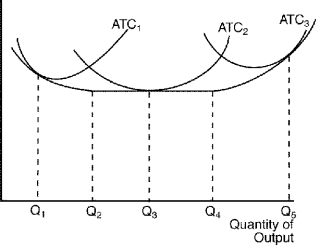A) exciting and fresh.
B) unimportant for understanding market structure.
C) dry and technical.
D) vibrant and enthralling.
Correct Answer

verified
Correct Answer
verified
True/False
Marginal costs are costs that do not vary with the quantity of output produced.
Correct Answer

verified
Correct Answer
verified
Multiple Choice
At what level of output will average variable cost equal average total cost?
A) when marginal cost equals average total cost
B) for all levels of output in which average variable cost is falling
C) when marginal cost equals average variable cost
D) There is no level of output where this occurs,as long as fixed costs are positive.
Correct Answer

verified
Correct Answer
verified
Multiple Choice
When marginal cost is rising,average variable cost
A) must be rising.
B) must be falling.
C) must be constant.
D) could be rising or falling.
Correct Answer

verified
Correct Answer
verified
Multiple Choice
In the long run Firm A incurs total costs of $1,200 when output is 30 units and $1,400 when output is 40 units.Firm A exhibits
A) diseconomies of scale because total cost is rising as output rises.
B) diseconomies of scale because average total cost is rising as output rises.
C) economies of scale because total cost is rising as output rises.
D) economies of scale because average total cost is falling as output rises.
Correct Answer

verified
Correct Answer
verified
Multiple Choice
Table 12-7
The Flying Elvis Copter Rides
 -Refer to Table 12-7.What is the value of O?
-Refer to Table 12-7.What is the value of O?
A) $40
B) $140
C) $360
D) $410
Correct Answer

verified
Correct Answer
verified
Multiple Choice
Accounting profit is equal to
A) marginal revenue minus marginal cost.
B) total revenue minus the explicit cost of producing goods and services.
C) total revenue minus the opportunity cost of producing goods and services.
D) average revenue minus the average cost of producing the last unit of a good or service.
Correct Answer

verified
Correct Answer
verified
Multiple Choice
Table 12-7
The Flying Elvis Copter Rides
 -Refer to Table 12-7.What is the value of D?
-Refer to Table 12-7.What is the value of D?
A) $25
B) $50
C) $100
D) $200
Correct Answer

verified
Correct Answer
verified
Multiple Choice
In the short run,a firm incurs fixed costs
A) only if it incurs variable costs.
B) only if it produces no output.
C) only if it produces a positive quantity of output.
D) whether it produces output or not.
Correct Answer

verified
Correct Answer
verified
Multiple Choice
Figure 12-10  -Refer to Figure 12-10.The firm experiences constant returns to scale if it changes its level of output from
-Refer to Figure 12-10.The firm experiences constant returns to scale if it changes its level of output from
A) Q1 to Q2.
B) Q2 to Q4.
C) Q1 to Q3.
D) Q4 to Q5.
Correct Answer

verified
Correct Answer
verified
True/False
The shape of the total-cost curve is inversely related to the shape of the production function.
Correct Answer

verified
Correct Answer
verified
Multiple Choice
Figure 12-10  -Refer to Figure 12-10.The firm experiences economies of scale if it changes its level of output from
-Refer to Figure 12-10.The firm experiences economies of scale if it changes its level of output from
A) Q1 to Q2.
B) Q2 to Q3.
C) Q3 to Q4.
D) Q4 to Q5.
Correct Answer

verified
Correct Answer
verified
Multiple Choice
Variable cost divided by quantity produced is
A) average total cost.
B) marginal cost.
C) profit.
D) None of the above is correct.
Correct Answer

verified
Correct Answer
verified
Multiple Choice
Table 12-8
 -Refer to Table 12-8.What is the shape of the marginal cost curve for this firm?
-Refer to Table 12-8.What is the shape of the marginal cost curve for this firm?
A) constant
B) upward-sloping
C) downward-sloping
D) U-shaped
Correct Answer

verified
Correct Answer
verified
Multiple Choice
Table 12-7
The Flying Elvis Copter Rides
 -Refer to Table 12-7.What is the value of I?
-Refer to Table 12-7.What is the value of I?
A) $110
B) $120
C) $220
D) $270
Correct Answer

verified
Correct Answer
verified
Multiple Choice
If long-run average total cost decreases as the quantity of output increases,the firm is experiencing
A) economies of scale.
B) diseconomies of scale.
C) coordination problems arising from the large size of the firm.
D) fixed costs greatly exceeding variable costs.
Correct Answer

verified
Correct Answer
verified
Multiple Choice
Since the 1980s,Wal-Mart stores have appeared in almost every community in America.Wal-Mart buys its goods in large quantities and,therefore,at cheaper prices.Wal-Mart also locates its stores where land prices are low,usually outside of the community business district.Many customers shop at Wal-Mart because of low prices.Local retailers,like the neighborhood drug store,often go out of business because they lose customers.This story demonstrates that
A) consumers do not react to changing prices.
B) there are diseconomies of scale in retail sales.
C) there are economies of scale in retail sales.
D) there are diminishing returns to producing and selling retail goods.
Correct Answer

verified
Correct Answer
verified
Multiple Choice
In the long run,
A) inputs that were fixed in the short run remain fixed.
B) inputs that were fixed in the short run become variable.
C) inputs that were variable in the short run become fixed.
D) variable inputs are rarely used.
Correct Answer

verified
Correct Answer
verified
Multiple Choice
Figure 12-10  -Refer to Figure 12-10.The three average total cost curves on the diagram labeled ATC1,ATC2,and ATC3 most likely correspond to three different
-Refer to Figure 12-10.The three average total cost curves on the diagram labeled ATC1,ATC2,and ATC3 most likely correspond to three different
A) time horizons.
B) products.
C) firms.
D) factory sizes.
Correct Answer

verified
Correct Answer
verified
True/False
In some cases,specialization allows larger factories to produce goods at a lower average cost than smaller factories.
Correct Answer

verified
Correct Answer
verified
Showing 281 - 300 of 533
Related Exams